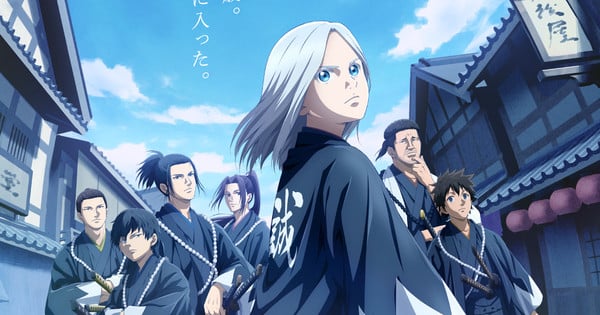© Tsuyoshi Yasuda, KODANSHA/ “Blue Miburo” Production Committee.
For many anime fans, merely mentioning the Shinsengumi will usually elicit some reaction. Awe, perhaps historic reverence. But almost always, there will be a twinge of nostalgia—not for the swordsmen themselves, but for the outsized role they’ve played in manga and anime. For all their controversies and their muddled place in history, the Shinsengumi are pop culture favorites. They’re romanticized as elite swordsmen, protectors, vigilantes, and stalwart defenders of a code of ethics that is more of an idea than a reality.
And now, another series joins their ranks—Blue Miburo, also commonly known as The Blue Wolves of Mibu. Based on a manga series by Tsuyoshi Yasuda (DAYS, Over Drive), the anime series by ytv animation is slated to premiere later this fall on October 12. Fans willing to wake up early for the first day of Anime Expo were treated to the world premiere of the first episode, followed by a Q&A with director Kumiko Habara and animation producer Hiroya Nakata.
Blue Miburo also follows the exploits of the Shinsengumi but starts with its early days, when the group was just a sub-faction of the masterless samurai originally hired to protect the shogun. They formed what became known as the Miburo—the ronin of Mibu, which would eventually become the Shinsengumi. Blue Miburo also adds another twist—rather than focusing on just the samurai, they examine the Bakumatsu era through the eyes of the most unseen—the children.
In the first episode, we’re introduced to real-life Shinsengumi commanders Hijikata Toshizou and Okita Souji, visiting 1860s Kyoto. While there, they visit a restaurant where they hear mumblings of a ring of kidnappers who have been abducting children. As circumstances would dictate, we’re also introduced to two orphans, who have been raised by the shop’s elderly proprietor—a young girl, and a white-haired boy named Nio. Unbeknownst to them, they’re used as bait by Souji to lure out the kidnappers. Predictably, Nio is angry when he realizes he’s been used—in a speech that reveals wisdom beyond his years, he talks about the vulnerability of children, the way they’re passed around to suit agendas and later discarded. There’s clear trauma behind his anger, which will presumably be unpacked at some point in the series, though he resents his inability to protect his sister the most. Still reeling with hurt and betrayal, he agrees to be taken in by the Miburo and trained alongside other youth.
Blue Miburo holds a lot of promise judging from its first impression. There is of course the romanticized cool of the proto-Shinsengumi. Toshizou and Souji are handsome and fierce, with the former a bit of a curmudgeon, and the latter a smiling devil that hides his lethal skills. In the fight with the abductors, he leaps from a building and cheerfully tells his ambushed foe that he’s already been hit. It doesn’t take a big stretch to realize he’s capable of more. It also shows the balance of comedy and drama that the series tries to straddle—there are moments of slapstick with the shopkeeper that feel exasperatingly shoe-horned in. There are also instances of tonal juxtaposition between Souji and Toshizou that feel a little more earned.
Both Habara and Nakata agreed to consider this mix of comedy and drama during the casting process. “We wanted to make sure whoever was cast could switch back and forth between these two settings—comedy and serious situations,” Nakata said. Habara agreed, adding that every casting decision was made very carefully. “For all the characters, even minor characters, I wanted to make sure I took time and care in choosing who will play each one.”
The same care went into the score and soundtrack, which was composed by Yuki Hayashi, who’s also lent his talents to properties like My Hero Academia and Haikyuu!! . “He’s from Kyoto, so that’s one of the reasons we asked him to do the music,” said Nakata. “We wanted him to incorporate traditional Japanese instruments, but we also talked about including some rap lyrics, which you can see in the opening theme song.” This blend of traditional and modern is showcased perfectly in said theme, which combines sweeping orchestral melodies with a thudding taiko backbeat. On top floats the slick, laid-back vocals of Okinawan rapper OZWorld. It feels like a good encapsulation of what they’re trying to do with the series—an exploration of contrasts blending history and fiction, comedy and dark drama, heroes and anti-heroes.
During early production, Habara strived for accuracy, not only with the manga source material but also with the setting. She frequently visited Kyoto for research, drawing on its rich history for inspiration. “There are still houses which swordsmen lived in,” she told the audience. “They’re still preserved. I scouted these areas as much as possible. I wanted to make sure everything was recreated as accurately as possible.”
When asked about the importance of the setting, she added, “160 years ago, Kyoto was a place where children couldn’t live freely without fearing for their lives. Having these children work alongside the Shinsengumi… one of the things we wanted to give was a mixture of fact and fiction… What if we had a perspective from a child?”
The irony, perhaps, is that the story is told from the memories of an old man to a gaggle of small children eager for a tale. But what are memories but one’s version of the truth? If the rest of Blue Miburo is anything like the first episode, this may be a worthy inclusion into the grand pantheon of Shinsengumi stories. Anyone who wasn’t fortunate enough to be in that panel room will have to wait until the fall to get a taste.
>>> Read full article>>>
Copyright for syndicated content belongs to the linked Source : AnimeNewsNetwork – https://www.animenewsnetwork.com/convention/2024/all-the-announcements-from-anime-expo/blue-miburo-anime-series-world-premiere/.212565
